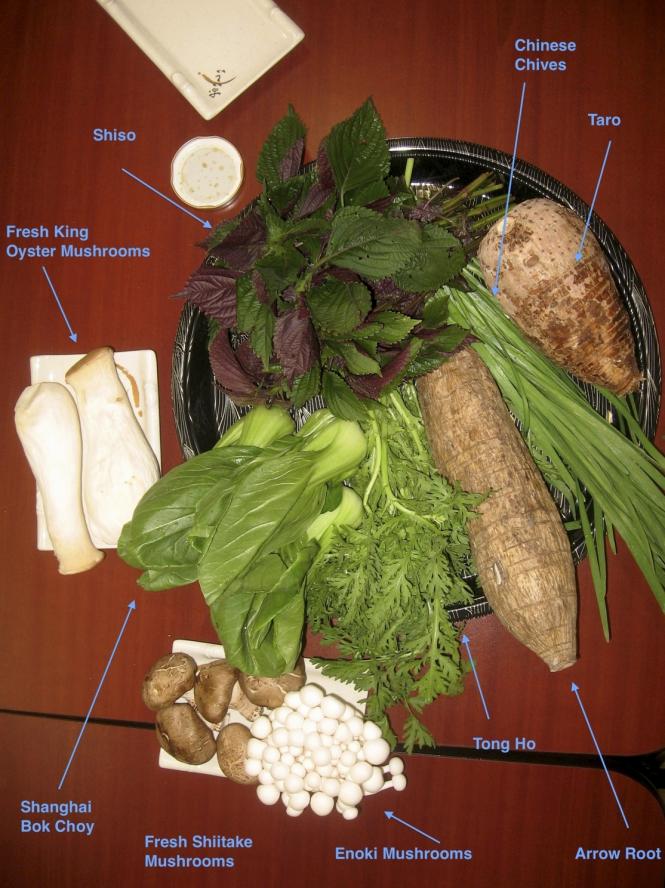Yours truly has a superficial acquaintance with Asian cooking. I’ve made Pad Thai and sesame salmon for friends, and they’re still speaking to me. But on my first visit to United Noodles, any remaining illusions about my supposed savvy with Far East cuisine rapidly went south. Too. Much. Information. Head about to explode.
Hunkered down among warehouses and wholesalers in the Seward neighborhood of south Minneapolis, United Noodles is the reigning emperor of pan-Asian groceries in the Midwest. Founded in 1972 as a wholesale noodle business by native Filipino Ramon Tan, it has expanded through the decades, serving the growing immigrant populations of Hmong, Vietnamese, Cambodians, Laotians, Chinese, Koreans, and other Asian nations who make the Twin Cities their home.
“Grocery” seems such a puny word for this place. It’s like calling The Great Wall of China a fence. This cavernous Pacific Rim redoubt features over 8,000 items from China, Japan, Taiwan, Hong Kong, Vietnam, Thailand, Indonesia, Malaysia, Singapore, Korea, India, Sri Lanka, and the Philippines. All those goods are spread over 15,000 square feet, with the store divided by country. As I wandered the aisles, I thought they might have to send out a search party for me. I could envision myself getting lost in the Korean section and having to subsist on Kimchi and ginseng candy for weeks.
At United Noodles, they take the concept of one-stop shopping very seriously. You’ll find tea, meats, produce, supplements, herbs, spices, coconut milk and curry, canned goods, snacks, soups, dried fruit, rice, and noodles, noodles, noodles – udon, soba and the real ramen (not those fossilized clumps of starch and sodium that college students subsist on). If you can’t find an Asian foodstuff at United Noodles, you’ll probably have to board a Korean Air or Thai Airways flight.
For this occidental tourist, the store presented an embarrassment of riches. It seemed like every other item on the shelf was intriguing and completely unknown to me. It was hard to shake the notion that there was a glorious foodie party going on, and that I was missing out. What the heck is durian fruit? What do you do with Kafir lime leaves? Dried mandarin orange slices? Leek flower sauce?
How do you say “Help!” in Mandarin?
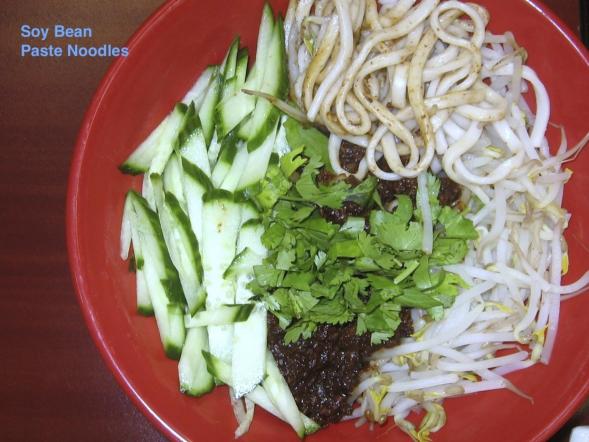 Soy bean paste noodles from UniDeli
Soy bean paste noodles from UniDeli
THAT IS TSO NOT REAL CHINESE CUISINE
Naturally, United Noodles is popular with foodies, chefs, and restaurants in the Twin Cities area. Want to make fresh poi for a summer dinner party? United Noodles stocks fresh taro. Looking for squid? Browse their frozen foods section, where there are enough of the cephalopods to comprise its own Octopi Wall Street. And the store also does a brisk business online.
Alice Fung became a co-owner of United Noodles in 2005. Soon after, her son Eric signed on as co-owner and general manager. They’ve made it part of their mission to engage and educate consumers, demystifying Asian cooking, or, at least, disabusing folks of the notion that General Tso’s chicken is authentic. And soon, they plan to feature cooking demonstrations in addition to their regular Sunday food samplings.
“There’s a huge barrier of entry for consumers of Asian goods,” Eric says. “I think what the reader wants to know is, ‘What exact products do you want to try?’”
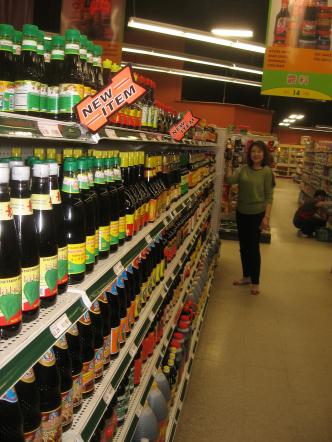 Alice Fung in the soy sauce aisle at United NoodlesFor example, if you say, “I’m
looking for soy sauce,” that’s like asking for cereal without specifying
whether you want Cheerios or Fruit Loops, Eric told me. United Noodles stocks
some 50 varieties of soy. The fermenting and aging process for soy sauce can be
as varied as that of different beers. Some brands are brewed naturally, using
toasted wheat, soybeans, salt and water. Mass produced brands of soy sauce
often replace the fermenting process, using a chemical process called
hydrolysis to break down the soy proteins. There are light, dark, sweet and
flavored soy sauces as well as blended varieties, which contain mushrooms or
other ingredients. Dark soy sauce usually contains caramel or molasses and is
often used in sauces and marinades. It tends to be less salty than light soy
sauce. There are at least 10 distinct kinds of Chinese soy sauce. But some Chinese recipes may even specify a Japanese soy sauce called Tamari.
Alice Fung in the soy sauce aisle at United NoodlesFor example, if you say, “I’m
looking for soy sauce,” that’s like asking for cereal without specifying
whether you want Cheerios or Fruit Loops, Eric told me. United Noodles stocks
some 50 varieties of soy. The fermenting and aging process for soy sauce can be
as varied as that of different beers. Some brands are brewed naturally, using
toasted wheat, soybeans, salt and water. Mass produced brands of soy sauce
often replace the fermenting process, using a chemical process called
hydrolysis to break down the soy proteins. There are light, dark, sweet and
flavored soy sauces as well as blended varieties, which contain mushrooms or
other ingredients. Dark soy sauce usually contains caramel or molasses and is
often used in sauces and marinades. It tends to be less salty than light soy
sauce. There are at least 10 distinct kinds of Chinese soy sauce. But some Chinese recipes may even specify a Japanese soy sauce called Tamari.
For the uninitiated – or if you’re simply hungry – a good starting point is the store’s on-site café, Unideli, which features fresh Chinese and Japanese dishes. Unideli’s barbecued pork is cooked at a low temperature for hours. They also feature Nabeyaki Udon, a Japanese noodle dish served in an earthenware pot. Or you can nosh on hard-boiled tea eggs, a traditional snack that’s popular in China and Taiwan. The eggs are marinated in anise, giving them a faint licorice tang.
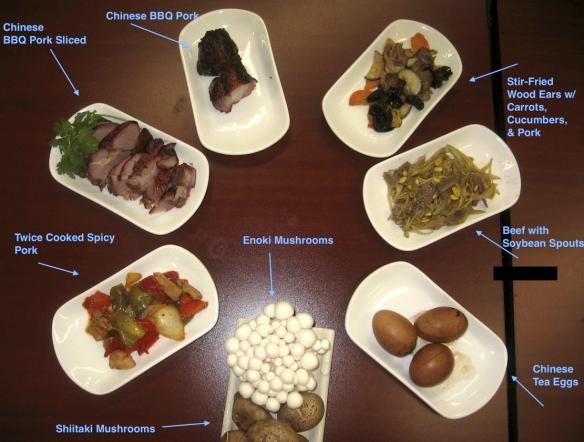 Options on the UniDeli menu
Options on the UniDeli menu
Prepared by Eric’s aunt, Judy Yen, and sushi chef Kosuke Zaworski, the Unideli menu is one of the best advertisements for the ingredients on the shelves at United Noodles.
“We use the Unideli as a platform to show people what they can do,” Eric says.
He says that changes to their website will streamline the process of shopping. Click on a recipe, and you will immediately get a list of the necessary ingredients to add to your shopping cart.
“It’s going to be a recipe based website that makes you savvier the more you use it,” Eric explains.
“It is local as far the community we’ve built,” Eric Fung says. “The different ethnic groups in the city come together at United Noodles.”
United Noodles is located at 2015 East 24th Street. Minneapolis, MN 55404. Hours: 9 a.m. to 7 p.m. Monday to Saturday and 9 a.m. to 6 p.m. Sunday. The Unideli is open 11 a.m. to 6 p.m. Tuesday through Saturday and from 11 a.m. to 5 p.m. Sunday, and is closed on Mondays.
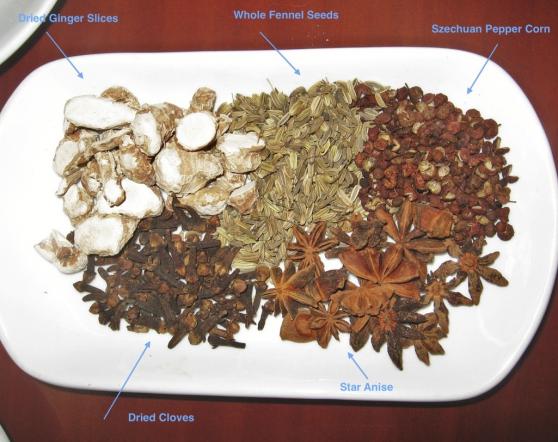 Some of the spices that make up a Chinese pantry
Some of the spices that make up a Chinese pantry
PANTRY LIST
For newbies like me who want to expand their repertoire of Asian dishes but don’t know where to begin, Eric Fung provided a list of essential Chinese ingredients to stock in your pantry:
Jasmine Rice: Rice is a staple in most Asian cooking. Japanese rice tends to have a stickier texture than Thai Jasmine or Basmati rice.
Soy Sauce: You won’t get far without this 2,500 year old condiment. Eric recommends starting with “one brewed” soy sauce, which is brewed directly from a fermentation process using wheat, soybeans, salt, and water without additional ingredients) and blended soy sauce (with additional ingredients, such as mushrooms). He says Chinese chefs often prefer Kimlan brand soy sauces.
Prepared Black Bean Sauce: “Fermented Black Bean Sauce is often mixed with ground pork to make a variety of dishes, including Chinese Bolognaise Noodles and Mapo Tofu,” Eric says.
Chile Oil: Used to add heat to Chinese dishes, Chile Oil is often found in Sichuan and Hunan cooking.
Hoisin Sauce: Made with mashed soy beans, Hoisin sauce is often found in Cantonese dishes, such as spring rolls, mu shu pork, and barbecued pork.
Oyster Sauce: “This is a thick viscous dark brown condiment made with sugar, salt, cornstarch, and oyster essence. Oyster Sauce is used not only in Chinese cooking, but also virtually all distinct Southeast Asian cuisines.”
Plum Sauce: “A fruity sweet and sour sauce made with peaches or apricot. This condiment is often used as a dipping sauce in deep-fried dishes, such as spring rolls, egg rolls, as well as roast duck.”
Sesame Oil: “A fragrant flavor enhancer used often, but in small amounts.”
Rice Wine: “Shao Hsing brand rice cooking wine is used almost as frequently as soy sauce in stir-fry dishes and fried rice.”
Five-Spice Powder: “A mixture of star anise, cloves, Chinese cinnamon, Sichuan pepper, and fennel seeds, often used as a rub for poultry and meat dishes.”
Sichuan Peppercorns: “A pungent seedpod that is used whole in soup stocks or grounded and added as a flavor enhancer.”
Star Anise: “An aromatic liquorish spice used to make Chinese soup stocks, often removed before serving.”
White Pepper Powder: “Made from the seed of pepper plants, white pepper powder has a unique flavor that found in a variety of stir-fry dishes.”
TRY THIS RECIPE
One of my favorite dishes from the United Noodles Unideli was a tofu dish that is made with agedashi sauce, ginger, and green onions. The helpful and patient Eric Fung provided me with his own recipe. It’s relatively simple one that won’t sprain your brain.
Agedashi Tofu
Recipe by Eric Fung
Serves 2
Ingredients
- 1 Package Firm Tofu
- ½ Cup Corn Starch
- 1 Tbsp Ajinomoto Hondashi
- ¼ Cup Kikkoman Aji-Mirin
- 2 Tbsp Kikkoman Soy Sauce
- ¼ Cup Green Onions
- ¼ Cup Daikon
- 1 Cup Water
Instructions
- For the Sauce: In a small saucepan, bring water to a boil. Stir in Hondashi, and cook on low heat for 2 minutes. Remove and stir in Aji-Mirin and Soy Sauce.
- Drain all liquid out of the Tofu package.
- Chop Green Onions and grate Daikon.
- Cut Tofu in 6 equal pieces. (Use only 4 pieces)
- Dredge Tofu in Corn Starch.
- Fry Tofu in 350ºF Oil for 2 Minutes.
- Place Tofu pieces in Bowl. Pour Sauce on the sides of the Tofu.
- Garnish with Green Onions and Daiko

William Loeffler moved to the Twin Cities area from Pittsburgh, Pennsylvania, where he spent 15 years as a features reporter for the Pittsburgh Tribune-Review. A playwright, he has also interviewed Bill Cosby, Yoko Ono and Eric Idle. He has written about his travels to all seven continents as well as his experiences running seven Boston Marathons. This is his first post for SGT.

